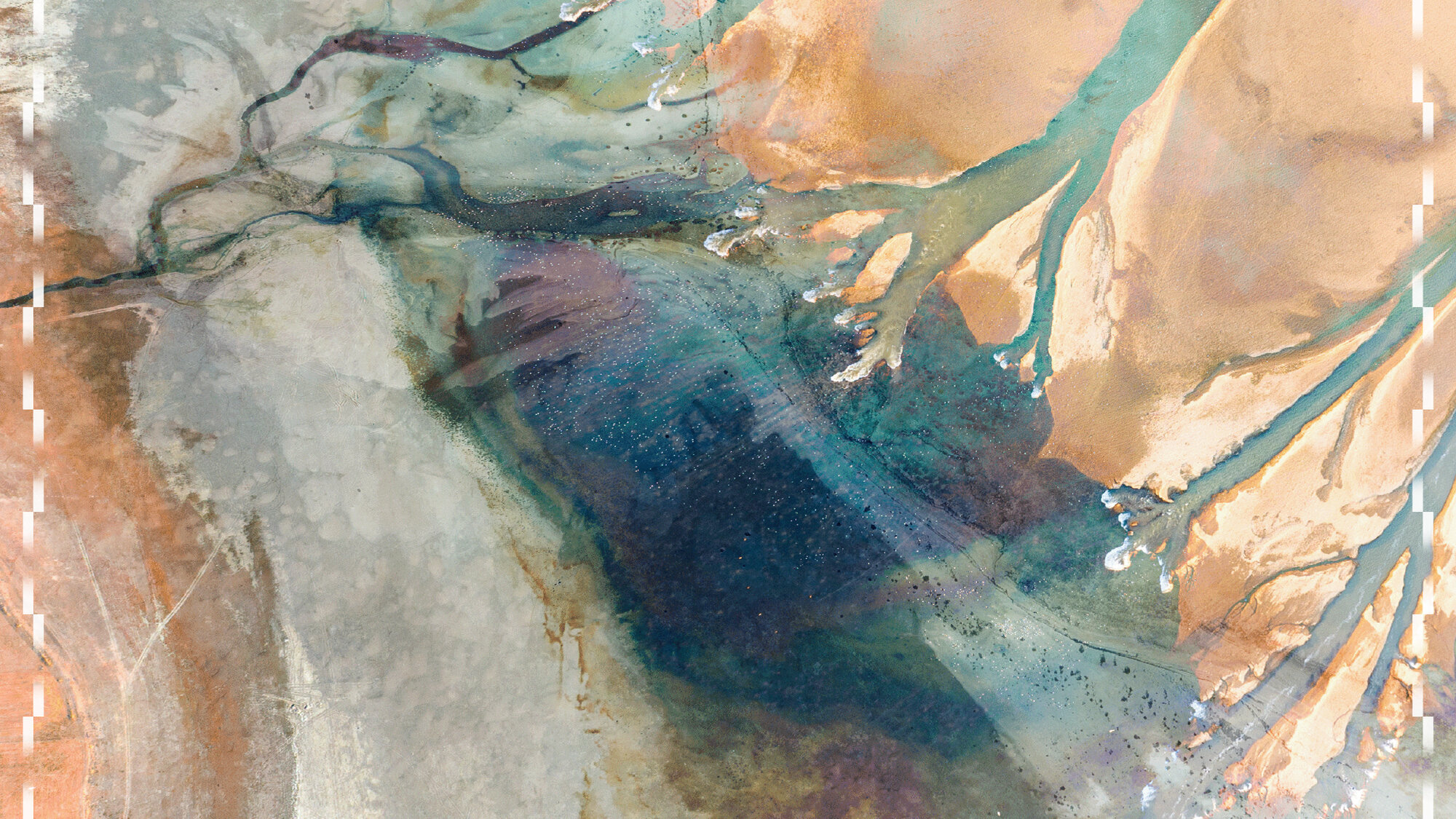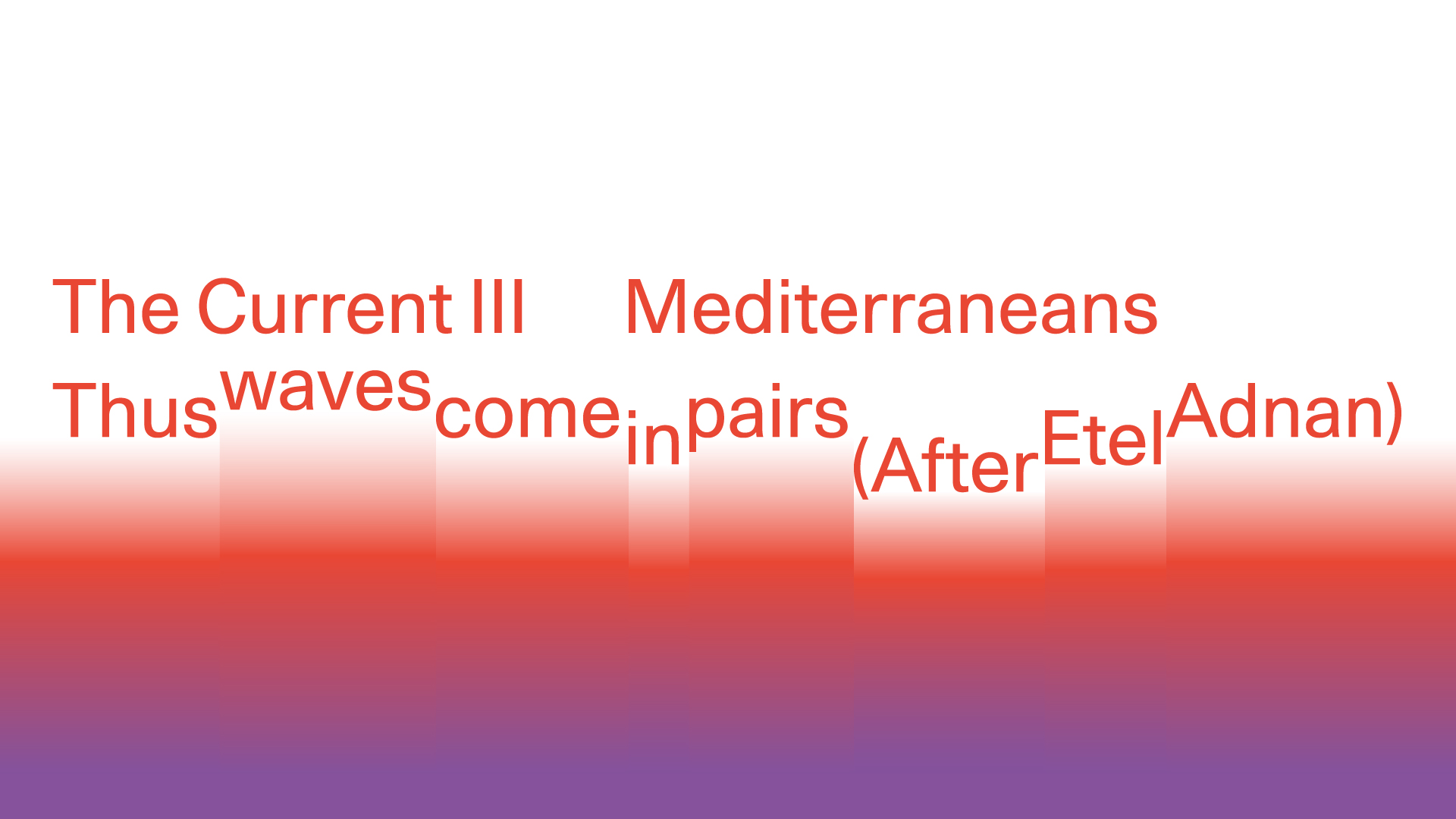The Current III: Mediterraneans
Text by Barbara Casavecchia
“Waves come in pairs,” says a beautiful poem by Etel Adnan, which we have taken as a lead to think with waves and open up to propagation, perturbations, and fluid exchanges of energy. The Current III is now in its second year and bases its modes of operation on collaborations, the possibility of being moved by others, and the attempt to work across scales, from the micro to the planetary. It expands from Venice and its lagoon to criss-cross ‘the middle sea’ in many ways - for instance, ways that invite us to meditate on how To Become a Sea, as proposed by a new podcast (in English, Arabic, and Italian) jointly created by Beirut-based artist Ibrahim Nehme and Sardinian collective Cherimus.
The Mediterraneans are a plural and polycentric site of knowledge production, where epistemic questions on who creates narratives around it, and from which perspective and shores, are central. “Mediterranean thinking (…) favors creolization and fragmentation over the universalism of dominant Western thought. As such, Mediterranean thinking is always plural, shaped by the scattered specificities of the experiences moving throughout its vast and ever-changing frame”, writes Chiara Cartuccia, one of the many scholars, artists, activists, thinkers, and practitioners who participated in the last semester of OCEAN / UNI, titled after a poem by Andrée Chedid, asking to imagine an ocean dry as lavender. The online exhibition now unfolding from those intense months of shared research and conversations (available on Ocean-Archive.org) expands its topic by means of visual and sonic imaginaries created by artists, reflecting upon desertification, water cycles, pollution, systemic violence, local ecological knowledges, human and more-than-human relations, and possible future solutions.
Can we learn to see heat waves as we do with sea waves and to see them coming in pairs? To think plurally with the interconnectedness of shifting climates and warming seas in the Mediterraneans means to think within a rapidly changing present condition, where colonial geopolitical and economic zoning is being redefined, while conventional maps often do not offer this fluid point of view. The latest IPCC report identifies the Mediterranean basin not only as a biodiversity hotspot but also as a climatic hotspot, warming 20% faster than the global average, with a predicted reduction of winter rains by around 40%. At the time of writing, the main rivers bringing sediments and waters to the Venetian lagoon lost up to 70-80% of their bodies, while salty waters are moving in from the deltas.
To think with mobility (of people, information, commodities, marine species, hurricanes, and wildfires) requires multi-scalar approaches and new modes of analysis. Suppose the future is increasingly described and regulated by predictive models based on the artificial capacity to mine data and interpret emerging patterns. What happens when many hotspots are only marginally included in these surveys while being at the forefront of change and adaptation? Can the fast-moving margins of the Mediterraneans help us to rethink Mediterraneization as a global issue rather than a localized one?
In the final episode of the podcast Aridity Lines, developed in collaboration with curator Reem Shadid, professor Eyal Weizman reflects upon environmental colonialism and how natural cycles can mobilize political processes and imaginaries. Since the Mediterraneans are transforming, he says, we need to start looking at a chaotic system of acceleration and study local manifestations of global problems that are often dragged into the sea. “Think of sandstorms as continents and entire landscapes moving in the air, affecting migrations above and below the water.”
To walk along Mediterranean waters has been a constant practice since the beginning of The Current III. It informed a methodology where research could align with a slow pace and rhythm, consistency, economy of means, and the importance of finding low-impacting ways of being on the ground, out in the open, and open to listening. We are now in the third iteration of Venice as a model for the future?, a cycle of free itinerant conversations around the Venetian lagoon, curated with Pietro Consolandi and guided by activists, scientists, and guardians of this body of water and its inhabitants. They operate as possibilities for coming together, learning together, and developing habits of noticing, as Anna Tsing suggests. It takes time to extend experiential rhizomes. It was by walking on a salt marsh in Campalto that I first learned why a swamp is best described as an arid space, due to the minimal presence of sweet water and a population of species that knows how to adapt to it.
Walking in silence for days with a small group forming a ‘wavy line,’ guided by the Venetian artist Giorgio Andreotta Calò from inlet to inlet of the same lagoon, it became clearer how, as humans, we can unsee the complexities of a liquid landscape and its ever-shifting borders. In July 2022, we gathered again in a small group to situate our observations on the Sardinian island of Asinara. This site has a complex history: once used as a quarantine station, penal colony, concentration camp, and high-security prison, since the ‘90s, the island is now a national park and marine protected area, where humans have the right to inhabit only temporarily, while albino donkeys, wild horses, migratory birds, cetaceans and Posidonia are permanent residents. Guided by the words of scientists, conservationists, rangers, and fishermen, we have tried to read the site-specific markers of climate change while discussing demarcations, binarisms, surveillance and punishment, and poetic and climatic justice.
While the Venetian lagoon hosts a fossil dune, thousand years old, Asinara hosts Centaurea horrida, endemic thorny knapweed, also classified as a living fossil, since it appeared here around 30 million years ago, even before Sardinia detached itself from the continental shelf. It lives on rocks and can resist strong sea winds and droughts.
Can we reshape the structure of our relations by learning from a coastal dune and a coastal plant? To resist constant erosion (of energy and resources) by holding on to an invisible structure of thin roots while retaining the ability to move in response to the wind, like waves? To adopt ways of working based on long-durational practices and collaborations, kinships, solidarities, sisterhoods, cycles of presence, and care? If slow violence has a powerful impact on living ecosystems and beings, often detected only in retrospect, slow regenerative practices have an often imperceptible and yet fundamental power to restore them for the years to come.
About The Current III:
Organized as a three-year-long curatorial fellowship program, The Current is a pioneering initiative that cultivates transdisciplinary practices and the exchange of ideas around bodies of water and their understanding.
It aims to form strong connections to local networks, map the contemporary issues concerning watery worlds, and weave them into an interdisciplinary conversation, embracing the spheres of science, conservation, policy, and education. The Current strives to explore and co-create common grounds among various disciplines concerning the Ocean through the means of proximity, collaborative research, and long-term engagement.
Each cycle of The Current is led by one or more curatorial fellows selected by the Academy, who in turn nominate artists, scientists, environmentalists, and other cultural actors to join a collective research project unfolding over three years. Since its inception in 2015, cycles of the Fellowship program have been led by curators Ute Meta Bauer and Chus Martínez and the artist group SUPERFLEX.
With the working title “Mediterraneans: ‘Thus waves come in pairs’ (after Etel Adnan),” the first stream of The Current III cycle is led by Barbara Casavecchia as a transdisciplinary and transregional exercise in sensing and learning with by supporting situated projects, collective pedagogies, and voices along the Mediterranean shores across art, culture, science, conservation, and activism.
Barbara Casavecchia is a writer, independent curator, and educator based in Milan, where she teaches at the Department of Visual Cultures and Curatorial Practices of the Brera Academy since 2011. She currently holds a course in Critical Writing at NABA, Milan. Contributing editor of Frieze magazine, her articles and essays have been published in art-agenda, ArtReview, D/La Repubblica, Flash Art, Mousse, Nero, South, and Spike, amongst others, as well as in artist books and catalogues. In 2018, she curated the solo exhibition “Susan Hiller, Social Facts” at OGR, Turin. In 2020, she acted as Mentor of the Ocean Fellowship Program offered by TBA21–Academy at Ocean Space in Venice. In 2021–2023, Barbara is leading The Current III.




































